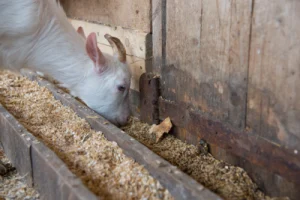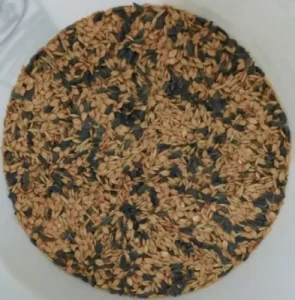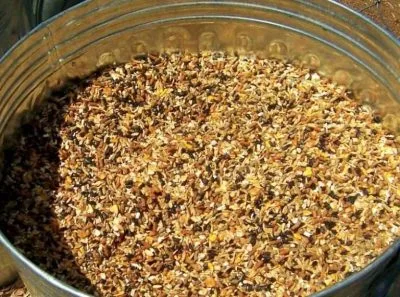No products in the cart.
Goat
Homemade Goat Feed: 3 DIY Recipes (Step by Step)
Commercial goat feed products are surely convenient and can save farmers a lot of effort.
But, besides the high cost, this type of goat feed may contain GMOs that are harmful to your goats.
A homemade goat feed recipe is a way for you to not only save money but also provide a healthy, nutritious meal for your goats.
Scroll down to learn 3 of our recipes so you can make your own homemade goat feed!
*This post may have affiliate links, which means I may receive commissions if you choose to purchase through links I provide (at no extra cost to you). As an Amazon Associate I earn from qualifying purchases. Please read my disclaimer for additional details.
Why Make Your Own Homemade Goat Feed?

Feeding your goats with your own recipe not only can save you a lot of money but is also much healthier for your goats in the long run.
Though buying the pre-mix at the stores may be quicker and more convenient for busy farm life, it is always more expensive than buying our own raw ingredients and mixing them ourselves.
Not only is it cheaper, but it is also healthier for your goats.
Pre-mix products usually have GMO corn which might have pesticide remnants that are harmful to your livestock.
Making your own recipes allows you to have full control over what you feed the goats.
You can even grow your own ingredients which surely requires more effort and labor, but it will definitely pay off and is definitely a DIY goat feed.
Read More: Best Goat Milking Machines for small-scale operations and homesteading. We put the top milking machines to the test and here are our results!
Things To Prepare

Feeding goats with grains are a way to replace hay or pasture-based diets, which are usually more costly to buy.
Pretty much all goat grain diets can be used, as both dairy and meat goat feed mix recipes require food that has high energy and is rich in protein.
Standard goat grain usually contains around 16 – 18% of protein.
Rich sources of energy can be found easily in the market are soybean, peanut, and cottonseed.
Cereal grains like oats, barley, corn, and rye are also both cheap and nutritious for your goats.
Ingredients for the mix should be easy to access and purchase at your local markets or suppliers.
If not, you will have to spend extra money on delivery or not be able to check the quality of them.
Weigh The Measuring Bucket
To make sure you give a precise amount and correct ratio of grain for your recipe, remember to weigh and exclude the measuring bucket’s weight.
Let’s say your empty bucket is 500g heavy (17.63oz), and you need 2 kilos of peanuts (4.4lbs).
The total weight of 1 bucket of peanuts should be 2.5kg (2 kg peanut + 0.5 kg bucket weight) or 5.5lbs (4.4lbs + 1.1lbs).
Read More: Can Ducks Eat Peanuts in the Shell? See if these salty snacks are safe for ducks to eat!
Homemade Goat Feed Recipes
Recipe #1: Alfalfa, Barley, Oats, Beans, Carob, Sunflower Seeds
The ratio for this recipe is:
- Alfalfa pellets: 4 parts
- Barley: 3 parts
- Oats: 3 parts
- Broad beans: 1 part
- Carob: 1 part
- Calculate the total amount and add 2% of the weight of sunflower seeds.
This homemade goat feed recipe can be given to goats based on their weight. Here is my suggestion:
- Milking goat: 1800gr
- Pregnant goat: 1400gr
- Normal goat: 1000gr
- Billy goat in breeding season: 1200gr
- Billy goat not in breeding season: 200gr
Recipe #2: Barley, Oats, Linseed Meal, Kelp meal, Molasses
With an aim to make my own healthy, corn-free meal for my goats, I have made this dairy goat feed recipe that turns out to be very cost-saving.
Plus, not only do the goats like this recipe but so do the cows.
Here are all the ingredients:
- Rolled barley: 50 lbs
- Crushed oats: 50 lbs
- Linseed meal: 3 lbs
- Kelp meal: 1lb
- Molasses (to combine all ingredients)
The main irreplaceable component of this recipe is barley.
For oats, you can replace them with other grains but make sure to notice the change in the protein content.
There should be 16-18% protein in this recipe to keep a healthy, sustainable diet for your goats.
To mix this recipe, first mix barley and oats well together. Then scatter the linseed and kelp meal. Finally, coat the mixture with molasses.
How much molasses is needed depends on the thickness you want your grain to be. On average, 12 cups of molasses in each 100lbs of grain is a suitable ratio.
This recipe can last up to 50 days during cool, dry days in big metal containers.
If it is humid and hot where you live then the storage time will definitely be altered.
Recipe #3: Barley, Peas, Wheat berries, Millet, Oats
This recipe will involve sprouting your grains. The ingredients include:
- Barley (11% protein): 5 parts
- Winter peas: 1 part
- Wheat berries: 1 part
- Millet: 2 parts
- Oats: 2 parts
All the ingredients should have no GMO and spray.
Before sprouting the grain, it is highly suggested to soak the mix in apple cider vinegar, which will help prevent the mix from molding.
Line your bucket with a pillowcase, or any soft fabric bag then pour in about ½ cup of apple vinegar.
Pour the dry grain then fill up the bucket with water.
Let the grain soak for 24 hours if possible, then drain them by hanging the pillowcase up in a dry area for about 12 hours.
At this point, you may be able to see some sprouts have already come out.
Pour the sprouts into a bucket and leave them in a warm place to keep sprouting till the next morning. At this point, the mix is ready to be used.
Depending on the body condition of your goats, you should adjust the number of feed sprouts.
Milking does need 2 cups of sprouts, 1 fistful of wheat bran, and half the mix of Chaffhaye.
Pregnant does will only need chaffhaye and hay with some added herbs.
In general, unless the goats are pregnant or milking, they won’t need grain. A diet of hay or pasture will be healthy enough.
Read more: Top 20 Dairy Goat breed for Milk production
FAQs
1. What should you not feed a goat?
You should not feed your goats leftover meat scraps, garlic, onions, caffeine, citrus fruits, chocolate, avocadoes, raw potatoes, kale, and quite a few different natural flowers and bushes.
Read More: Can My Chickens Eat Onions? See if chickens can safely eat onions and if they’ll give their eggs an off taste!
2. Is corn good for goats?
In small amounts, corn is good for goats. In fact, corn is a favorite food for goats. But make sure to keep corn intake to less than 10% of their daily intake and that the corn is crushed.
Too much corn can lead to excess calcium intake and can result in urinary calculi and goats cannot digest whole corn.
3. Can goats live on hay alone?
Goats do not actually need grains to thrive. They can thrive on 2 to 4 pounds of hay per day, but they do require roughage for their rumen to work properly.
4. Can goats live on grass alone?
While goats can graze on pasture grass and hay, goats cannot live on grass alone. They do require a mix of hay and roughage, young trees, and hardy shrubs to thrive.
5. Can goats eat potato peels?
Goats can only eat the non-green parts of potato peels. The green part is toxic to goats and even cooking the peels will not remove the toxicity.
But if you cook the non-green potato peels, then yes, they are safe for goats to eat.
6. What is the fastest way to put weight on a goat?
The fastest, and healthiest, way to put weight on a goat is to feed them a diet high in carbohydrates, like grains, corn, or oats.
Bottom Line
Making your own goat feed recipe clearly requires more time and effort from farmers, but considering the fact that they are healthier for your goats and can save you money, DIY homemade goat feed is worth the hard work.
We hope this post is helpful to you. Happy farming!

